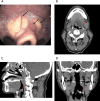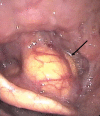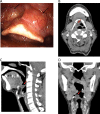A Retrospective Case Series of Anesthetic Patients With Epiglottic Cysts
- PMID: 34606575
- PMCID: PMC8500314
- DOI: 10.2344/anpr-68-01-01
A Retrospective Case Series of Anesthetic Patients With Epiglottic Cysts
Abstract
Previously undiagnosed or asymptomatic epiglottic cysts may be coincidentally detected during intubation. This retrospective case series identified undiagnosed epiglottic cysts that were discovered during intubation in 4 patients who underwent oral surgery under general anesthesia at our hospital during a 6-year period. Including 2 additional cases, 1 previously diagnosed and 1 detected during preoperative imaging, epiglottic cysts were observed in 6 of 1112 cases (0.54%) total. Among the undiagnosed epiglottic cyst cases, mild dyspnea on effort or snoring was reported in 2 patients, but all others were asymptomatic. Upon discovering previously undiagnosed epiglottic cysts during intubation, it is essential to proceed cautiously, remain alert for potential airway management difficulties, and avoid injuring or rupturing the cysts. In addition, any available preoperative imaging should be reviewed as information pertinent to the airway and any abnormalities may be useful. This report discusses the anesthetic care of 6 patients with epiglottic cysts that were previously known or initially discovered during intubation.
Keywords: Airway management; Epiglottic cyst; General anesthesia; Laryngoscopy.
© 2021 by the American Dental Society of Anesthesiology.
Figures






Similar articles
-
Asymptomatic giant epiglottic cyst causing an unexpectedly difficult airway: a case report.BMC Anesthesiol. 2025 Feb 19;25(1):85. doi: 10.1186/s12871-025-02948-9. BMC Anesthesiol. 2025. PMID: 39972287 Free PMC article.
-
AirWay Scope™ for Difficult Ventilation in a Patient With Epiglottic Cyst.Anesth Prog. 2018 Fall;65(3):204-205. doi: 10.2344/anpr-66-01-03. Anesth Prog. 2018. PMID: 30235438 Free PMC article.
-
[Utility of McGRATH MAC for a Patient with a Large Epiglottic Cyst].Masui. 2016 Jun;65(6):599-600. Masui. 2016. PMID: 27483654 Japanese.
-
Neonatal Lateral Epiglottic Defects.Ann Otol Rhinol Laryngol. 2021 Mar;130(3):311-313. doi: 10.1177/0003489420948546. Epub 2020 Aug 8. Ann Otol Rhinol Laryngol. 2021. PMID: 32772542 Review.
-
Shikani™ Seeing Optical Stylet-aided tracheal intubation in patients with a large epiglottic cyst.Chin Med J (Engl). 2011 Sep;124(17):2795-8. Chin Med J (Engl). 2011. PMID: 22040447 Review.
Cited by
-
Epiglottic Epidermoid Cyst: Cadaveric Case Report and Clinical-Surgical Applications.Cureus. 2023 May 4;15(5):e38539. doi: 10.7759/cureus.38539. eCollection 2023 May. Cureus. 2023. PMID: 37273349 Free PMC article.
-
An Uncommon Epiglottic Cyst Presentation in an Adolescent: A Case Report and Literature Review.Cureus. 2024 Feb 21;16(2):e54634. doi: 10.7759/cureus.54634. eCollection 2024 Feb. Cureus. 2024. PMID: 38524016 Free PMC article.
-
Comparison of intravenous nalbuphine and dexmedetomidine in combination with lidocaine aerosol inhalation in awake direct laryngoscopy: a randomized, double-blind, placebo-controlled trial.Perioper Med (Lond). 2024 Oct 19;13(1):105. doi: 10.1186/s13741-024-00461-0. Perioper Med (Lond). 2024. PMID: 39427184 Free PMC article.
-
Asymptomatic giant epiglottic cyst causing an unexpectedly difficult airway: a case report.BMC Anesthesiol. 2025 Feb 19;25(1):85. doi: 10.1186/s12871-025-02948-9. BMC Anesthesiol. 2025. PMID: 39972287 Free PMC article.
References
-
- Padfield A. Epiglottic cysts. A case report and review. Anaesthesia. 1972;27:84–88. - PubMed
-
- Asherson N. Large cysts of the epiglottis: a classification and case records. J Laryngol Otol. 1957;71:730–743. - PubMed
-
- Vorobeichik L, Hare GM, Zirkle M, Garavagia MM. Airway management of incidental vallecular cysts in adults. A A Case Rep. 2015;5:223–227. - PubMed
-
- Marseglia L, D'Angelo G, Impellizzeri P, et al. Neonatal stridor and laryngeal cyst: which comes first? Pediatric Int. 2017;59:115–117. - PubMed
-
- Gilbey P, Amirav I, Luder A. Vallecular cyst: rare cause of failure to thrive without respiratory distress in an infant. J Pediatr. 2011;159:869. - PubMed
MeSH terms
Substances
LinkOut - more resources
Full Text Sources

